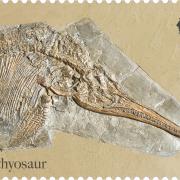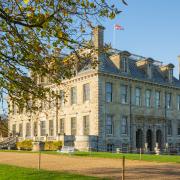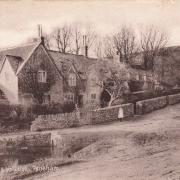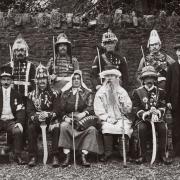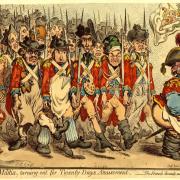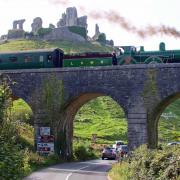Halloween is when the gap between the real and the netherworld is at its thinnest. Jon Woolcott, author of Real Dorset, explores curious stories from the county including a Dark Conjuror and Cold War spies on Portland
The Two Angels of Christian Charity

Piccadilly Circus is where you will find one of the most famous London statues. The winged figure, usually surrounded by tourists sitting on the steps at its base, is popularly known as Eros, but is his lesser-known brother, Anteros. Designed by sculptor Alfred Gilbert in 1893, it was a memorial to the 7th Earl of Shaftesbury, rather than a mildly scandalous and scantily clad Greek God of Love. Formally known as The Shaftesbury Memorial Fountain, it was originally called The Angel of Christian Charity.
The Earl in question, Anthony Ashley-Cooper (1801 – 1885), whose family seat was at Wimborne St Giles in Dorset (the statue points his arrow directly towards St Giles House), was a great 19th century reformer and Tory MP, largely responsible for the legislation that banned child labour in mines. Sadly, the Earl’s successors were often hit by tragedy – his eldest son committed suicide, shooting himself inside a cab in Regents Street in 1886. More recently the family have endured the murder of the 10th Earl, in 2004, and the sudden death of his 27-year-old son, the 11th Earl, who died of a heart attack in 2005. Following his career as a New York DJ, his younger brother (the current Earl), sometimes known as Nick AC, has undertaken sensitive restoration work, alongside his wife Dinah, at St Giles House.
During the award-winning restoration another statue of Eros/Anteros was discovered, and now this second figure occupies a prominent position in the gardens, pointing its arrow towards its more famous counterpart, 100 miles away.
Dorset's Mysterious Saint

Dorset’s patron saint is Saint Wite (Candida in Latin), after whom the county flag (Saint Wite’s cross) is named. She is a mysterious figure with several origin stories. One claims she was a hermit who lived on the cliff-top and was murdered during a Viking raid on Charmouth, another that she was martyred in what is now the Netherlands alongside Saint Boniface. There’s even a rumour that she was a Breton princess. The church that is associated with her is The Church of St Candida and Holy Cross in Whitchurch Canonicorum, in the Marshwood Vale. This magnificent church, which in parts dates from the 12th century, is known as the Cathedral of the Vale and is on the site of a Saxon church; it beautifully combines the Romanesque and Gothic styles. However, its fundamental oddity is located on the church’s north wall – what, at first sight, looks like a stone altar with three oval apertures along its base, is a shrine to Saint Wite. While the village never became a large-scale destination for pilgrims, local legend that the shrine had powers to heal the sick has kept a steady flow of visitors here since the 13th century. Hardly any Saints’ shrines survived the Reformation, this is one of only two Parish churches in England to have one, it remains a mystery as to why this Dorset shrine evaded discovery. Saint Wite’s reputed healing powers remain undimmed in the 21st century: when I visited several other pilgrims were there, leaving notes for Dorset’s patron saint in the apertures. Is this village church her final resting place? At the turn of the 20th century, during some restoration work, the tomb was opened, and the bones of a small woman were found in a casket which was inscribed: ‘Here Lies the Remains of St Wite.’
Portland’s Cold War Spies
Close to the sea on Portland’s western side is Southwell, dominated by a collection of post-war buildings which are now a school, and industrial units. It’s an exposed and windy place and would be innocuous if it wasn’t for a forgotten bit of history.
The buildings have a Cold War feel, as well they might as they were once the Defence Research Establishment, home of the Admiralty Underwater Weapons Establishment; they were also the centre of what became known as the Portland Spy Ring. Two of its employees who lived locally, Ethel Gee and Harry Houghton, had been passing secrets to the Russians for many years before they were arrested in 1960 on a trip to London to meet their KGB handler. They may have been caught sooner had the British Secret Services listened to Harry’s wife who had tipped them off, but they dismissed her as being jealous. She was right in this also – Ethel and Harry married when they left prison.
The couple were released in 1970 after their local MP made a speech to plead for clemency. A feature film about their story, Shadow of Treason, was made in 1964 and re-released when the couple left prison. Harry Houghton wrote a memoir of his experiences, Operation Portland: The Autobiography of a Spy. Eventually he and Ethel faded into obscurity; both died in Poole in the mid-1980s. I could find no blue plaque to commemorate their exploits. However, displaying typically Portland-ish humour, one road in the complex of buildings is Espionage Place.
A Scottish Queen’s Coffin

The Tarrant Valley, to the east of Blandford Forum, holds many fascinating secrets: an abandoned airfield, RAF Tarrant Rushton, from where the gliders that participated in the largely unsuccessful 1944 Arnhem Operation were launched; the site of one of architect Sir John Vanbrugh’s (1664-1726) largest stately homes Eastbury House near Tarrant Gunville, now mostly gone; and Tarrant Monkton where artist, author and printmaker Rena Gardiner (1929-1999) lived and worked.
But of all the villages, Tarrant Crawford is the most hidden, a collection of homes and a crossroads where the River Tarrant drains into the wider Stour. At the end of an unmarked lane is St Mary’s Church. Its undramatic exterior of flint and stone makes its interior both stunning and unexpected. Decorated with 14th century wall paintings, some in remarkable condition, I spotted amongst them three dancing skeletons. In medieval times this was also the site of a large Cistercian abbey.
Although nothing remains of it now, some of the building materials from the abbey may have been reused in the farm buildings and derelict tithe barn of Tarrant Abbey Farm. The former abbey was also the final resting place of Queen Joan of Scotland, daughter of King John, who died at the age of 28 and was supposedly buried in a gold coffin. The former splendour of this abbey has long vanished, the river drains slowly through a series of ponds and the world has passed by this peaceful corner of rural Dorset.
Half-In, Half-Out in Wimborne Minster

You might well think I have a bit of an obsession with unusual burials – you’re probably right, or maybe it’s just that Dorset specialises in them. Wimborne Minster, which has been in existence for over 1300 years, is a dominant, curious and compelling building. The exterior of this magnificent church dedicated to St Cuthburga was not much liked by the architectural historian and author of the Buildings of England series, Nikolaus Pevsner who described it as ‘uncouth’ and ‘imposing, but not beautiful.’ Pevsner rarely held his opinions in check.
Its interior is magnificent, though it can’t match Sherborne Abbey’s fan-vaulted nave for breath-taking beauty, but it has weirdness on its side. Most notable, for me, is the tomb of Anthony Ettricke. An antiquary and judge, he committed the unfortunate Duke of Monmouth for trial following the failed rebellion of 1685.
Ettricke has been described as ‘argumentative’ and one gets a sense of his character from his strongly held desire not to be buried in either a church or churchyard. Eventually his sarcophagus was installed in the walls of the Minster, neither in nor out. He was also fascinated by the year 1691, which if turned upside down reads 1691. It takes a certain sort of ego to apply this calendrical oddity to oneself, but he did, believing that this would be the year of his death. He went as far as to have the year etched onto the tomb. Unfortunately, he survived until October 1703, so the date was later altered, somewhat crudely. The original date of 1691 is so visible now that I can’t help but wonder if later restoration has done something to reveal it – and therefore helps to tell this extraordinary story.
The Dark Conjurer of Batcombe

In Dorset’s north-west is Batcombe, a village of just over a 100 residents. Frederick Treves, writing in 1906 publication Highways and Byways in Dorset, thought that many of the villagers had upped sticks because their isolated position left them bored! By the early 20th century, it was obvious that what drove people to bigger towns and cities certainly wasn’t a sense of ennui. The striking thing about Batcombe is its extraordinary position, at the bottom of a steep wooded slope, part of the line of hills which divide Dorset’s north from its south.
The Church of St Mary the Virgin is tucked close to the hill, and it’s this location which gave rise to a Dorset legend. Its square tower has four pinnacles, but according to local myth, one had once been toppled when a horse being ridden by the local squire, John Minterne, had leapt from the hill above, knocking the pinnacle off with its hooves.
Minterne, known ominously as ‘The Dark Conjurer of Batcombe’ was supposedly hurrying home because he had somehow intuited that his maid had entered his study and had found his only book – full of magic spells - and he was fearful that she might discover its secrets. Apparently, the pinnacle refused to be replaced, although I can only surmise that the magic has since diminished, as all four were firmly in place when I visited. It’s a curious story, and even Conjurer Minterne's dates are uncertain – he might have died in 1592 or 1716. And, he might have been buried in the wall of a small chapel in the churchyard, since demolished.
The Cerne Giantess

The Cerne Giant, overlooking the village of Cerne Abbas, is one of England’s best-known chalk hill figures; it is one of only two (extant) in Dorset – the other, at Osmington, is the figure of George III on horseback riding away from his favoured seaside resort, Weymouth. The priapic Cerne Giant, which has been in the National Trust’s care since the 1920s, is more fun for obvious and not so obvious reasons. Some of the appeal lies in his arresting club wielding form standing at 180 feet – muscular thighs and spaghetti arms; and much of it is the mystery surrounding its creation. His original purpose and age are still a matter for intense debate.
The May Day festivities here are joyful, beginning at dawn when the Wessex Morris Men dance at the Trendle next to the Cerne Giant – the edge being taken off this early hour by the local village pubs opening especially for this event. Women, including one of my friends, have been known to make their way to the top of his male appendage in the hope that his fertile spirit may help them become pregnant.
The hillside around the Giant has also been used playfully. Famously, on release of the Simpsons Movie in 2007, Lord Digby, the owner of the adjacent hillside allowed the production company to paint a temporary Homer Simpson (in his Y-fronts), about to throw a doughnut at the Giant’s organ, as a promotional stunt. More intriguingly, ten years earlier the historian Katherine Barker led a group of students who created a temporary taped-out companion on the hillside, a neat riposte to the original figure’s overbearing masculinity. An aerial photograph of the Cerne Giantess alongside the Cerne Giant reveals how convincing his new mate was.
Vanishing Villages and a Vanishing Lord
Lost settlements are a feature of Dorset – villages now only visible on the map in a gothic script. Plague is generally blamed for their disappearance, and it’s undeniable that this recurrent pandemic, which first arrived in Britain at Melcombe Regis near Weymouth in June 1348, had a significant part to play. However, the reasons for depopulation are often complex, a combination of changes in approaches to farming, land ownership patterns, the flight to towns and cities, new roads, and the arrival of the railway.
These ghost villages have an air of mystery, even if it’s sometimes hard to find their physical remains. One such is Bingham’s Melcombe, not far from its modern, near-namesake Melcombe Bingham. There’s nothing to see of the old village except the church and the grand house – by standing on the compost heap in the corner of the churchyard I could just make out that the field beyond, dotted with trees, had undulations marking the remains of its former dwellings and streets.
Bingham’s Melcombe is linked in the historical record to another village: Melcombe Horsey, a good half hour’s walk away, not far from the Dorsetshire Gap. Today, Melcombe Horsey is dominated by a few large farm buildings, and a house and chapel combined into one building – but this is the site of another lost village, similarly marked by bumps in a field. The two villages are hard to disentangle, but both seem to have become de-populated at the end of the 15th century – each has a distinct and eerie atmosphere. But they’re not the only vanishings. The grand isolated house at Bingham’s Melcombe was occupied by the Bingham family for 600 years until 1980 – one family member being Richard John Bingham, 7th Earl of Lucan, the gambler and likely nanny murderer Lord Lucan, who himself disappeared in 1974.
The Lost Henge

With its long coastline, Dorset was always a place where peoples came ashore - Romans, Vikings, Saxons and their forerunners. Dorset’s uplands are awash with archaeological sites, lumps and bumps in the landscape, a huge Cursus, barrows and hill forts. But we’re curiously lacking one common feature of pre-Roman civilisation – we have very few megaliths, a tiny number of dolmens, a small number of modestly sized stone circles. Almost all the stone circles and dolmens are clustered, unsurprisingly, around a quarry – the Valley of the Stones, close to where the land falls towards Chesil Beach and the sea, northeast of Abbotsbury. This area makes for a fascinating walk through history: from the Victorian Brutalist Hardy Monument built in 1844 to commemorate local Vice-Admiral Sir Thomas Hardy (Nelson’s ‘Kiss me, Hardy’) to the magnificent Hell Stone (a Neolithic dolmen) and two smaller stone circles including the remote and rather beautiful Kingston Russell.
Slightly less well-positioned, from the point of a view of the modern antiquarian traveller, is the stone circle at Winterborne Abbas, the Nine Stones, adjacent to the busy A35, on the outskirts of the village. Dorset folklore has usually resisted directly referencing the Devil in its names, but the Nine Stones has been said to represent Satan, his wife and their seven children. Curiously, in the writings of the 17th century traveller, John Aubrey, there’s a reference to another stone circle, around half a mile west of the Nine Stones. If it existed at all, it was probably dragged away for building material. But we do have the Broad Stone, a huge stone which once stood upright above the ground, but now lies flat on the verge by the road, in approximately the right spot for the lost henge. So maybe Aubrey was right.
The Nazi Arrows of Hinton St Mary
The north and east of Dorset was once dominated by large land-holding families, and one that looms large in the history of this part of the county are the Pitt Rivers. Augustus Pitt Rivers (1827-1900) is sometimes known as the father of modern archaeology as he was responsible for many innovations when conducting excavations on his Cranborne Chase estate, and after whom the Pitt Rivers Museum in Oxford is named. However, it was his grandson, George Pitt-Rivers (1890 – 1966) who attracted my attention. George made his home in the pretty village of Hinton St Mary, but became caught up, firstly, in population studies, then eugenics and finally, inevitably, with fascism. He published anti-Semitic works, attended rallies in Germany at Goering’s invitation, entertained Oswald Mosley and gave speeches blaming the Spanish Republicans for the bombing of Guernica.
At the outbreak of the Second World War, he was considered a security risk and interned in Brixton Prison for two years. I had heard two rumours about Pitt-Rivers: that he was on a British Security Service ‘kill list’ should the German invasion come, and that he had arrows pointing Luftwaffe bombers towards Bristol cut into crops near his home. I went in search of the potential sites for these arrows in the farmland around Hinton St Mary. It was an enjoyable bike ride, but I suspect these arrows are probably no more than a rumour; one local had said of George ‘he couldn’t have planted a crop to save his life.’ Locals have sensibly decided that George wasn’t worth bothering with, and instead remember his second wife Rosalind (née Henley). After their divorce in 1937, she became a pioneering biochemist. She visited the death camp at Belsen just after its liberation, an experience that reportedly stayed with her for the rest of her life.
Jon Woolcott's Real Dorset

With his own roots firmly planted in north Dorset, Jon Woolcott’s new book explores the lesser-known details of Dorset’s past and present, taking a series of journeys on foot and by bike across the county, uncovering the lost and forgotten, and creating a shadow history, an alternative guide to the place we love.
He stumbles across lost Neolithic earthworks, Victorian pleasure gardens and nightlife, the ‘model’ village of Milton Abbas and its modern equivalent at Poundbury, spy stories, vanished settlements and strange quirks of history. He also delves into the importance of the county for writers and artists including William Barnes, Sylvia Townsend Warner, John Piper, Derek Jarman, John Betjeman and Elisabeth Frink.
Jon, who works for the award-winning independent Dorset publisher Little Toller Books, will be revealing some of the oddities from his book that make Dorset unique at Dorset Museum on October 19 (dorsetmuseum.org) and Bridport Literary Festival on November 7 (bridlit.com).
Real Dorset is published by Seren Books (£9.99), available from bookshops or serenbooks.com.









